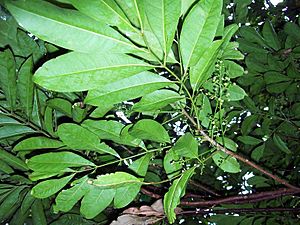White Tamarind facts for kids
Quick facts for kids White Tamarind |
|
|---|---|
 |
|
| Leaves and flowers | |
| Scientific classification | |
| Genus: |
Cupaniopsis
|
| Species: |
baileyana
|
| Synonyms | |
The Cupaniopsis baileyana is a type of flowering tree. It belongs to the soapberry family. This tree grows naturally in eastern Australia.
People often call it the White Tamarind or Toothed Tuckeroo. Its scientific name, baileyana, honors a botanist named F.M.Bailey.
This tree likes to grow at the edge of rainforests. It prefers rich soil and can be found in areas that are high up. Sometimes, it also grows in lower places. It is known as a pioneer species. This means it can be one of the first trees to grow in areas where the forest has been disturbed.
You can find Cupaniopsis baileyana growing from Newcastle, New South Wales, all the way up to Main Range National Park in south-eastern Queensland.
What Does It Look Like?
This tree is usually small, growing up to 13 meters (about 43 feet) tall. It has a very full and thick top, called a crown.
Its trunk is mostly round. Some trees might have flat, wide parts on their trunks, like small ridges. The bark is smooth and can be grey or brown. The smaller branches are green, quite smooth, and thick. They also have marks where old leaves used to be.
Leaves of the Tree
The leaves are made up of many smaller leaflets. Each leaf is about 17 to 30 centimeters (7 to 12 inches) long. They have 8 to 20 leaflets on them.
These leaflets are narrow and can be shaped like an oval or a spear. They can have small teeth along their edges or be smooth. Each leaflet is 4 to 9 centimeters (1.5 to 3.5 inches) long and 1 to 2.5 centimeters (0.4 to 1 inch) wide.
The main vein in the middle of the leaflet sticks out on both sides. Many smaller veins also stick out. You might see tiny bumps called Domatia where the main vein meets these side veins. This special feature helps tell this tree apart from similar ones like Cupaniopsis serrata and Cupaniopsis flagelliformis.
Flowers and Fruit
The Cupaniopsis baileyana tree produces creamy-colored flowers. These flowers grow in clusters called panicles. They usually appear in March.
After the flowers, the tree grows fruit. The fruit is a reddish-brown capsule with three parts. It is about 2 centimeters (0.8 inches) across. Inside, there are shiny black or brown seeds. These seeds are almost completely covered by a bright yellow to orange part called an aril. The fruit ripens between November and January.
Images for kids


